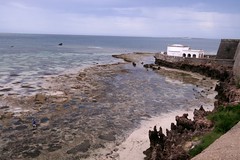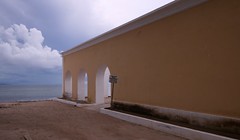As I mentioned in the last post, I was just in Mozambique. My first impressions took me back to Brazil - not only do they share the same language but also some other reminders of the former Portuguese occupation. Old cathedrals and colonial-style buildings can be seen throughout the country, as can lots of people with mixed African-European heritage. It was fun to be trying to speak Portuguese again - I think traveling there would have been difficult without even my very light grasp of the language. I found the people of Mozambique extremely friendly and happy to help this clueless estrangeiro get around, which was a challenge at times.
In Mozambique, the days start early - well before sunrise people are piling into overcrowded chapas, trucks and buses headed for work, school or the market. The roads are mostly unpaved and in bad shape, so travel times are extraordinary. For the best chance at arriving at your destination at a reasonable hour, you have to catch the earliest bus of the day. Sometimes this means getting out of bed at 2:30am to get yourself on a chapa; a seat on a chapa usually means a cramped spot in the back of a truck or minivan stuffed beyond double capacity. Sadly, most of my time in the country was been spent in transit this way. I was in Mozambique for only 8 days - enough time to stop in two places: Ilha de Mozambique and Pemba. I opted to rush into Tanzania because Mozambique turned out to be far more expensive than I had expected.
Ilha de Mozambique was well worth the effort of getting there. It is a small island off the coast of northern Mozambique famous for being the first European settlement in East Africa, set up by the Portuguese. In fact, it is where Mozambique got its name - the country is named after the island. It became a very important naval base and a key trading post, handling goods from mainland Africa, Arab traders and other Portuguese colonies including Goa, India. The colonial architecture on the island is well-maintained thanks to UNESCO and its a beautiful place to spend a couple days wandering around. The island is tiny - only 3km long and 500m wide - so its easily explored on foot.
From the island, I continued north to Pemba and spent a couple uneventful days there before doing the mad overland border crossing into Tanzania…

